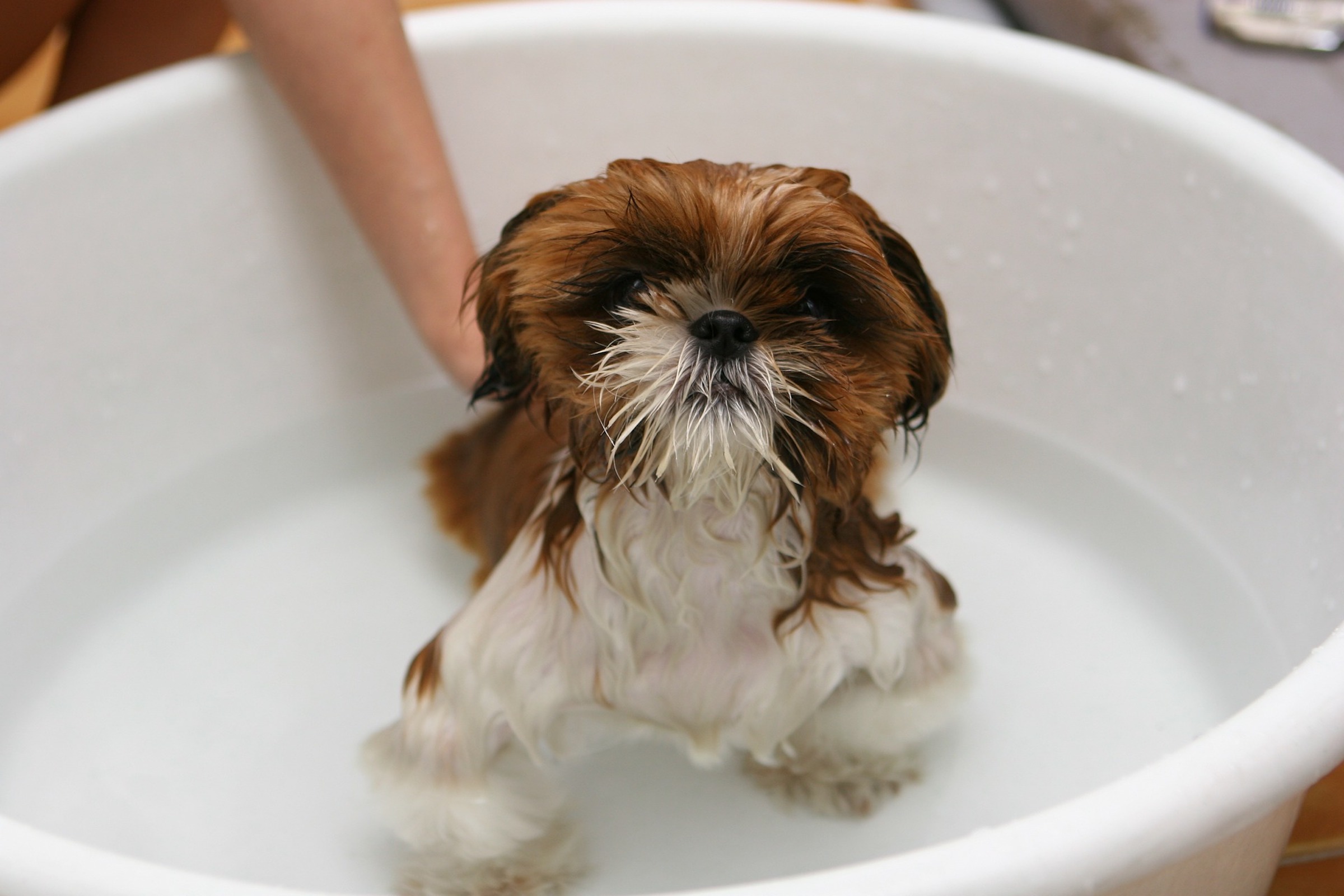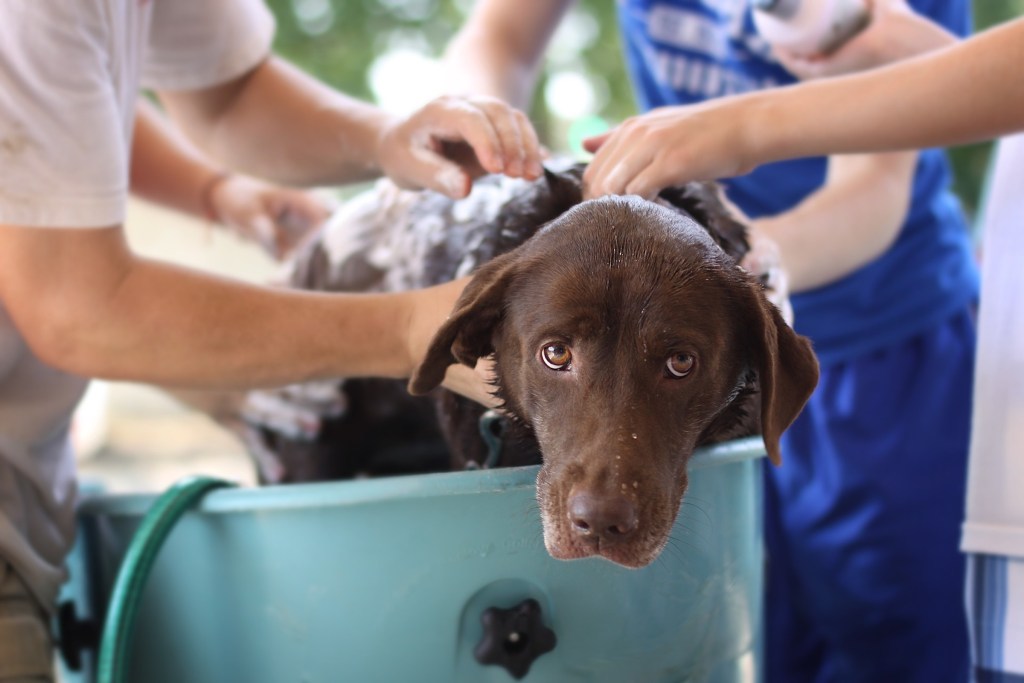Concocting homemade dog shampoo might sound like a tricky feat, especially if bathing your dog is difficult to begin with, but it’s actually easier than you think. In fact, you may have all the ingredients you need already waiting in your pantry. DIY dog shampoo will definitely require some water and a handy spray bottle, so don’t forget to gather all your supplies before you begin. Obviously, you’ll also need a place to wash your dog, like a bathtub or kiddie pool next to the backyard hose. Finally, it never hurts to have a couple of treats on hand to make bath time as easy as pie — your pup will surely thank you!

The best ingredients for dog shampoo
- Apart from the soapy material that gets all the dirt and oil from your dog’s fur, you’re sure to need water to make an effective shampoo. It’s just as important to wash away all soapy residue as it is to lather up your pup in the first place, as any leftover suds can lead to dry skin and irritation in any species.
- Oatmeal is another popular ingredient for dog washes and shampoo. With its anti-inflammatory and anti-itch properties, raw oatmeal is even known to relieve skin conditions like atopic dermatitis and other allergic irritations. It also provides a gentle exfoliation for skin and fur, which can help with those hard-to-reach spots.
- Essential oils are another surprising ingredient in many DIY and natural dog shampoos. Some of these oils have antiseptic, anti-bacterial, and even flea-repelling properties. It’s worth noting that pure essential oils should never be applied on or diffused near your dog — always dilute them! Not every essential oil is safe for use around pets, so it’s a good idea to double-check with your vet before making any substitutions.
What products not to use on dogs
Other than avoiding toxic essential oils (aka, any oils your vet hasn’t approved) in your dog’s shampoo, you should avoid using any hair products meant for humans. Even if your pup has hair rather than fur, she runs a much greater risk of skin irritation from using a shampoo meant for people. Don’t be fooled: Even natural products can lead to sensitivity!

DIY dog shampoo recipes
Here are some dog-friendly recipes for a shampoo you can make right at home:
Instant dog shampoo
According to the American Kennel Club (AKC), many DIY canine shampoos use a base combination of vinegar, dish/Castile soap, and baking soda. Once mixed thoroughly, this concoction has a pH level of 7, which is considered neutral and safest for your fur baby’s skin. Just mix equal parts of these ingredients in a bottle and grab your pup for bath time!
Oatmeal bath for dogs
This recipe includes many easy-to-find ingredients you may already have at home, including:
- Oatmeal (even instant oats will work, as long as they’re unflavored).
- Warm (not hot) water.
- High-fat milk, avocado oil, or vegetable oil (optional).
Yep, that’s all you need! You’ll start the process by making a powder out of the oatmeal using any food processor or blender. Mixing the oats and the water is the next step — once you have a milky, smooth liquid, you’re ready to go. If you use the third ingredient, either milk or oil, this is when to mix it in.
You can also directly mix the oat powder in a shallow bathtub of warm water. Gently pour the water over your pup’s body to take advantage of its soothing and moisturizing properties.
Flea-repellent dog shampoo
With this recipe from the AKC, your dog can stay flea- and tick-free completely naturally. There are no fancy directions, either — just combine the ingredients in a bottle and go!
Here’s what you’ll need:
- 10 ounces warm water
- 1 tablespoon Castile soap
- 2 ounces aloe vera gel
- 2 drops lavender essential oil
Don’t forget to rinse thoroughly, and be sure not to get any soap in your fur baby’s eyes!
Dog shampoo for dry skin
Here’s another recipe that’s perfect for pups with dry, itchy, or sensitive skin beneath their coat. The only ingredients you may need to search for or order are glycerin, baby shampoo, and aloe gel, though all can usually be found at your local grocery store or pharmacy. Simply mix the following in a spray bottle:
- 1 quart water
- 1 cup baby shampoo or dish soap
- 1 cup apple cider (or regular) vinegar
- 1/3 cup glycerin
- 2 tablespoons aloe vera gel
Aloe vera and glycerin are super soothing on sensitive skin, but aloe is great after sun exposure, too.
Whether you’re looking for a natural alternative to your dog’s regular shampoo or just want to try something new (and less expensive), making your pup’s hair products at home can be an awesome learning experience for you. For your dog, it’s a great opportunity to be pampered and even to get some relief from her dry skin symptoms. Ready to dive in?
Editors' Recommendations
- Why does my dog have a bald patch on their tail? Here are the answers you need
- Looking for signs your dog has ticks? These telltale symptoms mean you have a flea or tick problem
- Do puppies sleep a lot? These are the perfectly normal sleeping habits of a healthy pup
- Does your dog drink a lot of water? Here’s when you should be concerned
- Is your puppy breathing fast while sleeping? Here’s when you should worry and how to help your dog




